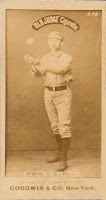In my perusings of back issues of The Sporting News, I often encounter tidbits that I believe are worth sharing, but that are not of sufficient length to stand alone as a blog posting.
I'm going to present them, from time to time, in trivia compilations. When a former colleague of mine did similar columns, he called it "browsing around the lot." hence my title.
* * *
The other night I was watching – believe it or not for the
first time – the 1961 movie Breakfast at
Tiffany’s, when I noticed in one Manhattan street scene a dark green box
van in the background with “Rogers Peet / Makers of Fine Clothes” painted on
the side.
Rogers Peet, a quality men’s haberdashery, operated from
1874 into the 1980s and produced a set of multi-sport cards in 1929-1930.
* * *
 At spring training with the Dodgers in
At spring training with the Dodgers in
By comparison, Rickey Henderson ran the 60 in 6.4 seconds.
The current record for the outdoor 60-yard dash seems to be
5.99 sec.
* * *
While playing with Independence
in the Kansas-Oklahoma-Missouri League in 1949, Mickey Mantle hit an
inside-the-park home run on Aug. 28 when his long fly ball hit the outfielder
on the top of the head, knocking him unconscious.
The hapless fielder was Bill Hornsby, son of Rogers Hornsby. The younger Hornsby played five seasons of minor league ball, virtually all of it in Class C and D leagues.
* * *
In 1962 Cincinnati Reds pitcher Bill Henry became the first
full-time pitcher to pitch in more games (40) than innings pitched (37.1). The
lefty relief pitcher was 4-2 that season.
Today, of course, in the era of specialty set-up men and
closers, such a ratio is common.
After four years in the Red Sox’ rotation, 1952-55, Henry
returned to the major leagues as a National League reliever with the Cubs
(1958-59), Reds (1960-65), Giants (1965-68), Pirates (1968) and Astros (1969),
starting just two games in those 12 years.
His lifetime record is 46-50 with an ERA of 3.26.
* * *
 To start the 1949 season, the Leavenworth Braves (Class C,
Western Association) lost what was believed to have been an Organized Baseball
record of 22 straight games.
To start the 1949 season, the Leavenworth Braves (Class C,
Western Association) lost what was believed to have been an Organized Baseball
record of 22 straight games.
On July 19 of the same year, they topped that with a second
major losing streak of 23 games.
Not surprisingly, other than manager Bill Cronin, there were
no former or future major leaguers on the team. That was the last team to
represent Leavenworth
in Organized Baseball.
* * *
Larry Doby, who integrated the American League with the Cleveland
Indians in 1947, is also credited with integrating the American Basketball
League.
On Dec. 30, 1947, he signed a contract with his hometown
Paterson (N.J.) Crescents (sometimes called the Panthers). The team finished
second in the league that season.
* * *
 Among the most common of the 1887-1890 Old Judge cigarette
cards are those of Arthur Irwin. He can be found on at least 13 different
photo/team variations.
Among the most common of the 1887-1890 Old Judge cigarette
cards are those of Arthur Irwin. He can be found on at least 13 different
photo/team variations.
Irwin is credited by some with inventing the infielder’s
glove.
He played, managed and coached in the major and minor
leagues from 1880 through 1921.
On July 16, 1921, while on the S.S. Calvin Austin en route
from New York to Boston he fell, jumped or was pushed
overboard. His body was never recovered.
* * *
 Ben Chapman, was a four-time All-Star, had a World’s Series
ring, was once banned from Organized Baseball for a year for slugging an umpire
and is often accused of being the loudest and most bigoted of Jackie Robinson’s
detractors in 1947.
Ben Chapman, was a four-time All-Star, had a World’s Series
ring, was once banned from Organized Baseball for a year for slugging an umpire
and is often accused of being the loudest and most bigoted of Jackie Robinson’s
detractors in 1947.
He was also an ambidextrous bowler. In 1945-46 he had a 180
average bowling right-handed and a 165 average as a leftie. Chapman owned a
bowling center (they were called bowling allies back then) in Montgomery, Ala.
* * *
 Myril Hoag had unimaginably small feet for a ballplayer.
Despite standing 5’11” and weighing 180 lbs., he was reported by some sources
to have worn a size 4 shoe on his right foot, 4-1/2 on the left. A photo in the
Aug. 3, 1944, Sporting News showed
Hoag comparing shoe sizes with a teammate and said Hoag wore a 5-1/2 or his
right foot and 4-1/2 on his left.
Myril Hoag had unimaginably small feet for a ballplayer.
Despite standing 5’11” and weighing 180 lbs., he was reported by some sources
to have worn a size 4 shoe on his right foot, 4-1/2 on the left. A photo in the
Aug. 3, 1944, Sporting News showed
Hoag comparing shoe sizes with a teammate and said Hoag wore a 5-1/2 or his
right foot and 4-1/2 on his left.
During his big season with Sacramento in the Pacific Coast
League in 1930, when he hit .337 with 17 homeruns, he was being scouted by many
major league teams. One remarked, “How can you tell your club to pay $35,000
for a guy wearing a lady’s size shoe?”
The Yankees took a chance and in 1931 Hoag began a 13-year
career in the American League.



No comments:
Post a Comment
Your comments, criticism, additional information, questions, etc., are welcome . . . as long as they are germane to the original topic. All comments are moderated before they are allowed to appear and spam comments are deleted before they ever appear. No "Anonymous User" comments are allowed.